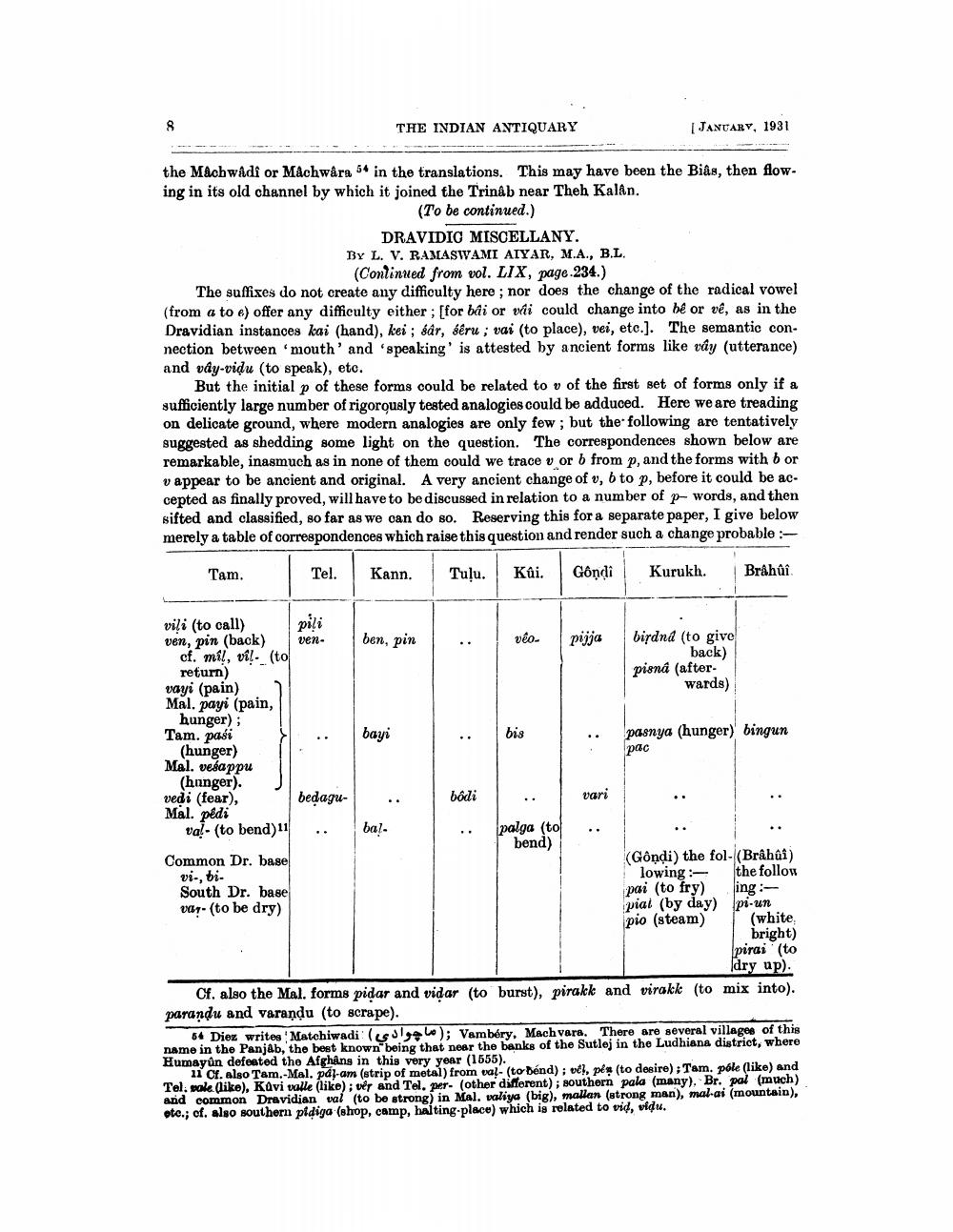________________
THE INDIAN ANTIQUARY
JANUARY, 1931
the MacbwAdi or MAchwârg 54 in the translations. This may have been the Bias, then flow. ing in its old channel by which it joined the Trinab near Theh Kalân.
(To be continued.) DRAVIDIC MISCELLANY. BY L. V. RAMASWAMI AIYAR, M.A., B.L.
(Continued from vol. LIX, page 234.) The suffixes do not create any difficulty here ; nor does the change of the radical vowel (from a to 6) offer any difficulty either ; [for bãi or vii could change into bé or vê, as in the Dravidian instances kai (hand), kei; sár, dêru; vai (to place), vei, etc.). The semantic connection between mouth' and 'speaking' is attested by ancient forms like ráy (utterance) and våy-vidu (to speak), etc.
But the initial p of these forms could be related to v of the first set of forms only if a sufficiently large number of rigorously tested analogies could be adduced. Here we are treading on delicate ground, where modern analogies are only few ; but the following are tentatively suggested as shedding some light on the question. The correspondences shown below are remarkable, inasmuch as in none of them could we trace v or 6 from p, and the forms with b or v appear to be ancient and original. A very ancient change of v, b to p, before it could be accepted as finally proved, will have to be discussed in relation to a number of p- words, and then sifted and classified, so far as we can do so. Reserving this for a separate paper, I give below merely a table of correspondences which raise this question and render such a change probable -
Tam.
Tel.
Kann.
Tuļu.
Kûi.
Gôndi
Kurukh.
Bráhûs
pili
vari
vili (to call) ven, pin (back) ven- ben, pin .. veo rijja birdna (to give cf. mil, vil. (to
back) return)
pisná (aftervayi (pain)
wards) Mal. payi (pain,
hunger); Tam. pasi ... bayi . bis .. pasnya (hunger) bingun (hunger)
. pac Mal. vešappu
(hunger). vedi (fear), bedagu- .. bôdi Mal. pédi va!-(to bend) 11 ..
palga (to ..
bend) Common Dr. base
(Gôndi) the fol- (Bråhui) vi., bi
lowing the follow South Dr. base
pai (to fry) ing :var- (to be dry)
piat (by day) pi-un pio (steam) (white
| bright) pirai (to
dry up). Cf. also the Mal, forms pidar and vidar (to burst), pirakk and virakk (to mix into). parandu and varandu (to scrape).
54 Diez writes Matchiwadi (usullo); Vambéry. Mach vara. There are several villages of this name in the Panjab, the best known being that near the banks of the Sutloj in the Ludhiana district, where Humayun defeated the Afgháns in this very year (1555).
11 Cf. also Tam.-Mal, páj-am (strip of motal) from val. (to Dónd) : ut), pé (to desire); Tam. póle (like) and Tel. wale (like), Kavi valle (like); vêr and Tel. per. (other different); southern pala (many). Br. pal (much) and common Dravidian val (to be strong) in Mal. valiya (big), mallan (strong man), mal-ai (mountain), etc.; cf. also southern pldiga (shop, camp, halting place) which is related to vid, vidu.




